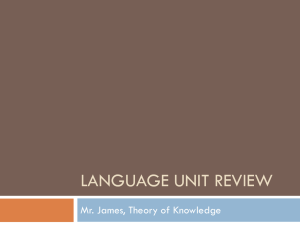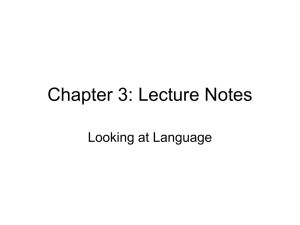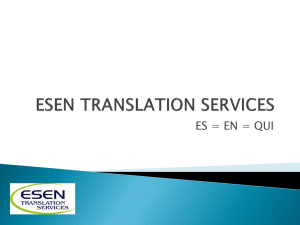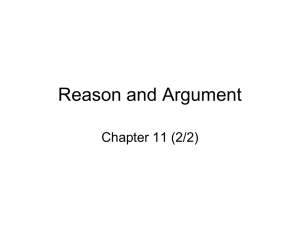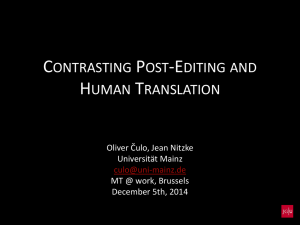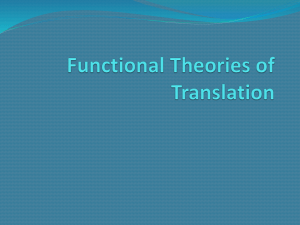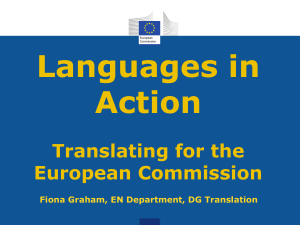Presentation - Lancaster University
advertisement
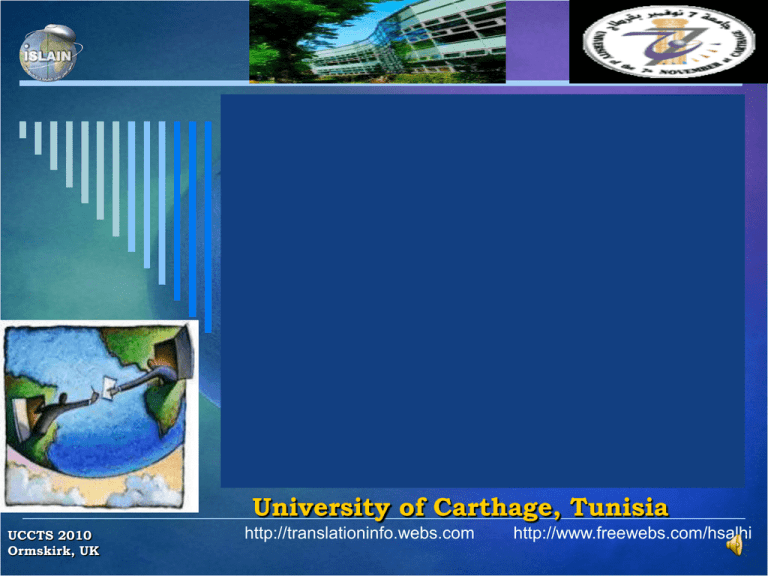
Hammouda Salhi University of Carthage, Tunisia UCCTS 2010 Ormskirk, UK http://translationinfo.webs.com http://www.freewebs.com/hsalhi U sing Corpora in Contrastive and Translation Studies (UCCTS 2010) 27th July 2010 - 29th July 2010 Edge Hill University, Ormskirk, UK UCCTS 2010 Ormskirk, UK http://translationinfo.webs.com http://www.freewebs.com/hsalhi T ranslating ambiguous lexical items using a parallel corpus: A case study of ‘good’ in the EAPCOUNT Hammouda Salhi University of Carthage, Tunisia hammouda_s@hotmail.com http://translationinfo.webs.com http://www.freewebs.com/hsalhi UCCTS 2010 Ormskirk, UK http://translationinfo.webs.com http://www.freewebs.com/hsalhi Slide 3 Polysemy in language and translation “Get” “Constitution” “Shall” ‘Polysemy is ubiquitous in language and its investigation has a considerable potential for illuminating human cognition’ (Brown and Witkowski, 1983:83) UCCTS 2010 Ormskirk, UK http://translationinfo.webs.com http://www.freewebs.com/hsalhi Slide 4 UCCTS 2010 Ormskirk, UK http://translationinfo.webs.com http://www.freewebs.com/hsalhi 5 Significance of lexical meaning “Would you please give your honest opinion about solutions to the food shortage in the rest of the world?” The survey was a huge failure... In Africa: “food” ??? In Eastern Europe: “honest” ??? In Western Europe: “shortage” ??? In China: “opinion” ??? In the Middle East: “solution” ??? In South America: “please” ??? And in the USA: “the rest of the world” ??? UCCTS 2010 Ormskirk, UK http://translationinfo.webs.com http://www.freewebs.com/hsalhi Slide 6 Aims: To draw attention to the centrality of lexical ambiguity in the translation process To propose a corpus approach for the investigation of CP in translation To reveal the ambiguous behavior of ‘good’ in the EAPCOUNT To show how to enhance translator training through insights into such an ambiguous behavior UCCTS 2010 Ormskirk, UK http://translationinfo.webs.com http://www.freewebs.com/hsalhi Slide 7 Presentation structure 1. Translation literature and lexical 2. 3. 4. 5. 6. UCCTS 2010 Ormskirk, UK ambiguity The Generative Lexicon theory The EAPCOUNT Translating prototypical meanings of items The ambiguous behavior of ‘good’ as revealed by the EAPCOUNT Final message http://translationinfo.webs.com http://www.freewebs.com/hsalhi Slide 8 UCCTS 2010 Ormskirk, UK http://translationinfo.webs.com http://www.freewebs.com/hsalhi 9 Translation literature and lexical ambiguity Lexical ambiguity is handled as part of : Structural ambiguity eg. Flying planes can be dangerous Some translation universals such as simplification (Toury, 1995) Problems of anaphoric reference, eg. Pronouns Gender problem, (Baker, 1992: 90) Taken : mainly from a paradigmatic perspective as a problem of vagueness and underspecification As an accidental problem in language and translation: treated on a case-by-case basis What is needed: an empirical investigation of lexical ambiguity in translation UCCTS 2010 Ormskirk, UK http://translationinfo.webs.com http://www.freewebs.com/hsalhi Slide 10 Developments NLP and MT Importance of lexical ambiguity Centrality of the disambiguation process: one of the greatest challenges for MT researchers (Ping, 2009) UCCTS 2010 Ormskirk, UK http://translationinfo.webs.com http://www.freewebs.com/hsalhi Slide 11 UCCTS 2010 Ormskirk, UK http://translationinfo.webs.com http://www.freewebs.com/hsalhi 12 The Generative Lexicon theory One of the main assumptions of the theory One of the main contributions Contrastive polysemy a. The bank of the river, b. The richest bank in the city (synchronically NOT related meanings) Complementary polysemy a. The school was built in 1932, b. What will you do when you finish school?, c. The Venetian school of painting, etc. (synchronically related meanings as they have a common core meaning and they complement each other in each context ) Prototypical meaning vs. word usage UCCTS 2010 Ormskirk, UK http://translationinfo.webs.com http://www.freewebs.com/hsalhi Slide 13 UCCTS 2010 Ormskirk, UK http://translationinfo.webs.com http://www.freewebs.com/hsalhi 14 The EAPCOUNT The English-Arabic Parallel Corpus Of United Nations Texts 261 texts aligned on a paragraph basis, and 6.8 million tokens Consists mainly, but not exclusively, of resolutions and annual reports issued by different UN organizations and institutions Time-frame of about 14 years (1996 – 2009): 93.87% of the texts were produced over a period of 9 years, namely from 2001 to 2009 UCCTS 2010 Ormskirk, UK http://translationinfo.webs.com http://www.freewebs.com/hsalhi Slide 15 Compiling the EAPCOUNT UCCTS 2010 Ormskirk, UK http://translationinfo.webs.com http://www.freewebs.com/hsalhi Slide 16 UCCTS 2010 Ormskirk, UK http://translationinfo.webs.com http://www.freewebs.com/hsalhi 17 Translating prototypical meanings items “bad offices do not yield good achievements” Arabic: ()مكاتب سيئة لم تسفر انجازات جيدة The offices of bad did not produce good achievements Chinese : (坏办事处不产生良好成绩) Office does not produce good results in bad French : (mauvais offices ne donnent pas de bonnes réalisations) Bad services do not give good realizations German : (Bad Büros nicht erbringen gute Leistungen) Good performances do not produce bath of office Italian : (uffici cattivo non danno buoni risultati) : offices I win doesn't give good results Portuguese : (escritórios ruim não rendem bons resultados) : offices bad not yield good results Spanish : (oficinas mal no dan buenos resultados): Offices badly do not give good results Swahili : (ofisi mbaya wala mavuno mafanikio mema): bad office success and good harvest UCCTS 2010 Ormskirk, UK http://translationinfo.webs.com http://www.freewebs.com/hsalhi Slide 18 The ambiguous behavior of ‘good’ in the EAPCOUNT The concordancer AntConc 3.2.1w found 326 instances of ‘good’ in the EAPCOUNT, 2 instances are nouns Total number of heads: 28 Number of Arabic equivalents: 22 324 instances of the adjective ‘good’ in the EAPCOUNT 22 different Arabic equivalents are found for ‘good’ in the corpus UCCTS 2010 Ormskirk, UK http://translationinfo.webs.com http://www.freewebs.com/hsalhi Slide 19 Occurrences of ‘good’ in the EAPCOUNT 1 UCCTS 2010 Ormskirk, UK http://translationinfo.webs.com http://www.freewebs.com/hsalhi Slide 20 Occurrences of ‘good’ in the EAPCOUNT 2 UCCTS 2010 Ormskirk, UK http://translationinfo.webs.com http://www.freewebs.com/hsalhi Slide 21 Case of domain-specific collocations Case of the equivalent ( رشيدraʃīd) ( رشيدraʃīd) literally ‘right-guided’, ‘following the right path’, etc.) 91 occurrences Good in this case collocates with only one head noun, namely Governance (2.77% of the heads) It is specific to the diplomatic context Case of the equivalent ( حميدةħamīda) ( حميدةħamīda) literally ‘benign’, ‘benignant’, etc.) 72 occurrances, Good in this case collocates with only one head noun, namely offices (masāʕin) (2.77% of the heads) It is specific to the diplomatic context When a collocation is domain-specific is becomes harder for trainees to find appropriate equivalents for both the node and collocate as it requires specialized knowledge of, say, diplomatic language UCCTS 2010 http://translationinfo.webs.com Slide 22 Ormskirk, UK http://www.freewebs.com/hsalhi Case of typical collocations Case of the equivalent ( جيدʒajid) ( جيدʒajid, literally ‘of good quality’, ‘well’, etc): 81 occurrences Good collocates with 20 different heads: (55.55% of the heads): Practice, relationships, cooperation, roads, political instincts, effect, progress, examples, alternatives, education, coordination, data, institutional capacity, level of awareness, job, living, position, start, stead. Trainees tend to attach to it more importance than it really merits UCCTS 2010 Ormskirk, UK http://translationinfo.webs.com http://www.freewebs.com/hsalhi Slide 23 Case of non-typical collocations Case of the equivalent (عظيمʕadhīm) عظيمʕadhīm, literally ‘magnificent’, ‘great’, etc): 2 occurrences Good in this case collocates with only one head noun, namely Friday (2.77% of the heads) Not a common collocation in the Arabic language, especially among the Muslim community UCCTS 2010 Ormskirk, UK http://translationinfo.webs.com http://www.freewebs.com/hsalhi Slide 24 General findings Ambiguity degree of good: 79% Good is a very ambiguous item. The number of heads modified by ‘good’ is 28 The number of existing equivalents is 22. In the 79% of the instances, good requires a new equivalent whenever it combines with a new head noun. The ambiguous behavior of this adjective and the establishment of equivalence at both word and collocation levels depend heavily on the head noun that it modifies. UCCTS 2010 Ormskirk, UK http://translationinfo.webs.com http://www.freewebs.com/hsalhi Slide 25 Final Message آخر الكالم Because the act of disambiguating items is part and parcel of the process of translation, lexical ambiguity should be handled as the norm rather than the exception in translation and the inner voice of professional translators should be heard now by trainee translators. Thank You Merci وشكرا ANY QUESTIONS ? UCCTS 2010 Ormskirk, UK http://translationinfo.webs.com http://www.freewebs.com/hsalhi Slide 26 Final Message آخر الكالم UCCTS 2010 Ormskirk, UK http://translationinfo.webs.com http://www.freewebs.com/hsalhi Slide 27 UCCTS 2010 Ormskirk, UK http://translationinfo.webs.com http://www.freewebs.com/hsalhi 28
